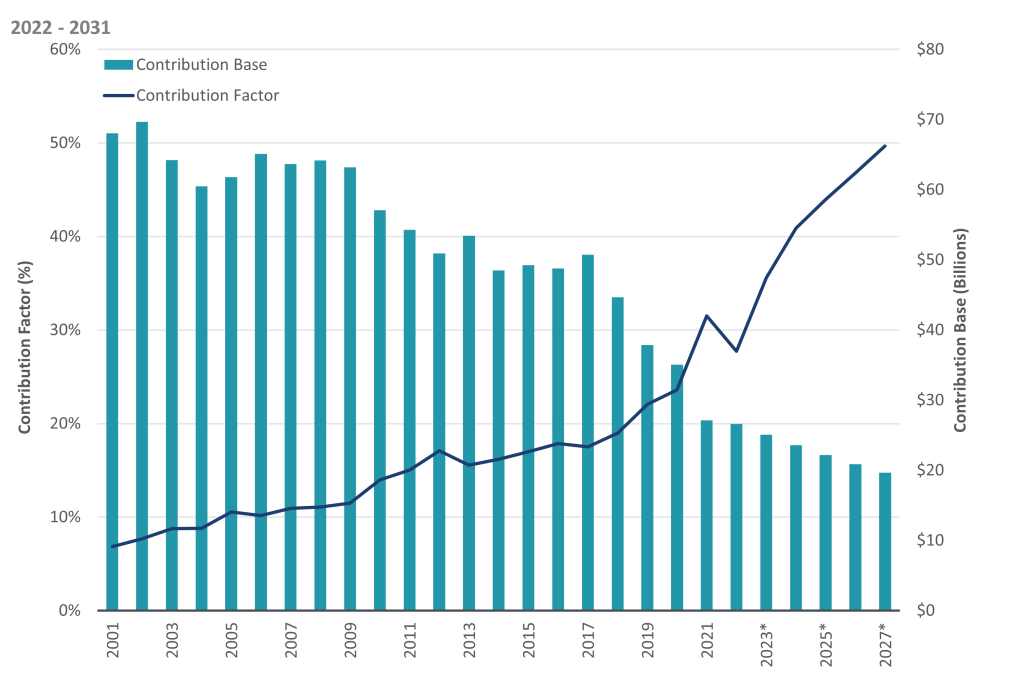- The Universal Service Fund subsidizes broadband deployment to close the gaps for those in unserved, underserved, rural, and low-income areas.
- Its current funding model needs to align with its current usage with Internet users subsidizing Internet deployment.
- Rather than targeting major tech companies with specific charges, a more equitable and effective solution is to expand the USF contribution base to include broadband service revenues.
In an era where Internet connectivity has become a critical utility, the United States Federal Communications Commission’s (FCC) Universal Service Fund (USF) remains a vital lifeline for ensuring every American has access to essential telecommunications services.
Established by the Telecommunications Act of 1996, the USF subsidizes broadband deployment to close the gaps for those in rural, underserved, and low-income areas. However, as the telecommunications landscape evolves, the funding model that supports this critical initiative needs modernizing.
Traditionally funded through fees collected from telecommunications companies, the USF’s reliance on interstate and international voice services has become problematic. With the industry’s swift transition toward Internet-based communication, the contribution base has faded, leading to an untenably high contribution factor that rose from around 7% in 2001 to over 34.5% in the third quarter of 2024 and is projected to climb to nearly 50% by 2027 if no changes are made. This excessive burden falls disproportionately on a narrow base of consumers, particularly those who depend primarily on voice services.
Recent discussions concerning the future of the USF have centered on a pressing question: how can we ensure that funding is both adequate and equitable? Among a range of proposals, two main ideas have emerged:
- Expanding the USF’s contribution base to include revenues from broadband Internet access services.
- Capturing contributions from tech giants like streaming providers, digital advertisers, and cloud service companies.
User Pays Promotes Fairness
Incorporating broadband service providers into the funding model through a fee levied on broadband revenues would provide a more balanced approach, potentially reducing the effective USF fee for consumers from 34.5% to around 3-4%. This shift adheres to sound economic principles and reflects the USF’s institutional history, advocating for a pricing structure that reduces distortion and promotes fairness.
When USF was initially rolled out, imposing the fees on voice made sense as connection meant a voice connection. However, voice is only around 11% of telecommunication revenues, receives minimal USF fund subsidy, yet pays 100% of the fees.
On the other hand, broadband service now accounts for 89% of the revenues, receives 60% of the USF fund as a subsidy for broadband deployment, and contributes 0%. This imbalance must be corrected, and broadband service should pay USF fees.

The Net Neutrality Order states that forbearing from imposing USF contributions on broadband providers serves public interest goals of broadband access and affordability. It quotes that assessing USF contributions to broadband services could result in a material increase in consumer broadband bills between USD 5 to 18 per month. It also states that the impact of these additional fees is likely to be highly regressive, with a disproportionate effect on low-income consumers who may be particularly sensitive to price increases. We dispute both these assertions.
Our work (see report) shows that consumers will avoid significant price increases under plausible assumptions for service plan prices. Many may even achieve savings due to the decreased contribution factor on voice services. For example, if that same broadband customer also has a voice line, the savings on the voice side will more than offset the increase on the broadband side.
One significant aspect is how this inclusion will impact different income groups. Broadband’s inclusion in the USF means that high-income users, who typically subscribe to more expensive broadband plans, will contribute more to the fund. Conversely, low-income users, who generally opt for less expensive broadband plans, will contribute less. This model aligns with the principle of progressive contribution, ensuring that the financial burden is shared based on the ability to pay.
Although there are understandable concerns about the financial strain on low-income consumers, the FCC has robust tools to mitigate these pressures. Programs such as the Lifeline Assistance Program are already in place to make vital communication services more accessible to those in need and ensure they are not disproportionately affected by new fees.
The Fallacy of Negligible Consumer Impact and Incentive Alignment if Big Tech is Taxed
The conversation has also turned towards imposing USF fees on industry titans like Amazon and Google. Advocates argue that these fees would not adversely impact consumers, as these corporations would absorb the costs rather than pass them down. However, this assumption overlooks reality. With shareholders and profit margins in mind, major firms often adjust pricing structures in response to increased costs, ultimately placing some burden back on consumers.
Additionally, targeting specific broadband uses for USF funding could stifle innovation and create economic distortions. Tech companies’ investment in developing cutting-edge services significantly enhances broadband’s value for consumers. Imposing fees on these companies might deter future investments, resulting in fewer options and potentially higher costs for users in the long run.
While funding the USF is essential to expanding access to crucial communication services, it is equally important to consider the broader implications of how we finance this initiative. Rather than targeting major tech companies with specific charges, a more equitable and effective solution lies in expanding the USF contribution base to include broadband service revenues.
As we navigate an ever-evolving telecommunications landscape, modernizing the USF contributions system is paramount to ensuring universal connectivity remains within reach for every American.
Contributors: Coleman Bazelon and Yong Paek, The Brattle Group.
Paroma Sanyal is a Principal at The Brattle Group’s Washington DC office and co-leads Brattle Telecom, Media, and Entertainment practice. She is a telecommunications industry expert specializing in spectrum policy, auctions, broadband, competition, regulation, consumer protection, and intellectual property matters.
The views expressed by the authors of this blog are their own and do not necessarily reflect the views of the Internet Society or, in this instance, The Brattle Group.


